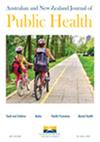行业对强制性怀孕警告标签设计规范的遵守不够理想
IF 2.4
3区 医学
Q2 PUBLIC, ENVIRONMENTAL & OCCUPATIONAL HEALTH
Australian and New Zealand Journal of Public Health
Pub Date : 2025-04-11
DOI:10.1016/j.anzjph.2025.100236
引用次数: 0
摘要
目的评估在澳大利亚酒类市场销售的产品是否按照设计要求显示了强制性的怀孕警告标签。方法:在2023年6月至11月期间,数据收集人员拍摄了来自悉尼三家酒类零售商的5964种独特的酒精产品。从3760件贴有强制性怀孕警告标签的产品中随机抽取20%的样本进行分析,以评估它们是否符合《食品标准守则》中概述的设计要求。结果在整个样本中,11%的产品没有正确显示强制怀孕标签。坚持饮用烈酒的比例最低(73%),其次是葡萄酒(90%)、啤酒(94%)和预混酒(97%)。就包装类型而言,在容量为800毫升的容器中,个人饮料的依从性最低(74%)。结论研究结果表明,强制性妊娠警告标签在澳大利亚酒类市场的应用可能不够理想。鉴于酒精含量较高,烈酒和葡萄酒产品的低依从性令人担忧。对公众健康的影响为优化强制性怀孕警告标签的有效性,必须按规格显示。需要进行持续的依从性监测,以改善依从性。本文章由计算机程序翻译,如有差异,请以英文原文为准。
Suboptimal industry adherence to the design specifications of the mandatory pregnancy warning label
Objective
To assess whether products sold in the Australian alcohol market are displaying the mandatory pregnancy warning label as per the design requirements.
Methods
Between June and November 2023, data collectors photographed 5,964 unique alcoholic products from three Sydney alcohol retailers. A random sample of 20% of the 3,760 products displaying the mandatory pregnancy warning label was analysed to assess whether they met the design requirements outlined in the Food Standards Code.
Results
Across the sample, 11% of products displaying the mandatory pregnancy label did not do so correctly. Adherence was lowest for spirits (73%), then wine (90%), beer (94%) and premix (97%). In terms of package type, adherence was lowest for individual beverages in containers >800 ml in volume (74%).
Conclusions
The findings indicate that the application of the mandatory pregnancy warning label may be suboptimal in the Australian alcohol market. The lower adherence among spirits and wine products is concerning given their higher alcohol content.
Implications for Public Health
For the effectiveness of the mandatory pregnancy warning label to be optimised, it must be displayed as per specifications. There is a need for ongoing compliance monitoring to improve adherence.
求助全文
通过发布文献求助,成功后即可免费获取论文全文。
去求助
来源期刊

Australian and New Zealand Journal of Public Health
医学-公共卫生、环境卫生与职业卫生
CiteScore
4.20
自引率
5.70%
发文量
121
审稿时长
6-12 weeks
期刊介绍:
The Australian and New Zealand Journal of Public Health (ANZJPH) is concerned with public health issues. The research reported includes formal epidemiological inquiries into the correlates and causes of diseases and health-related behaviour, analyses of public policy affecting health and disease, and detailed studies of the cultures and social structures within which health and illness exist. The Journal is multidisciplinary and aims to publish methodologically sound research from any of the academic disciplines that constitute public health.
 求助内容:
求助内容: 应助结果提醒方式:
应助结果提醒方式:


